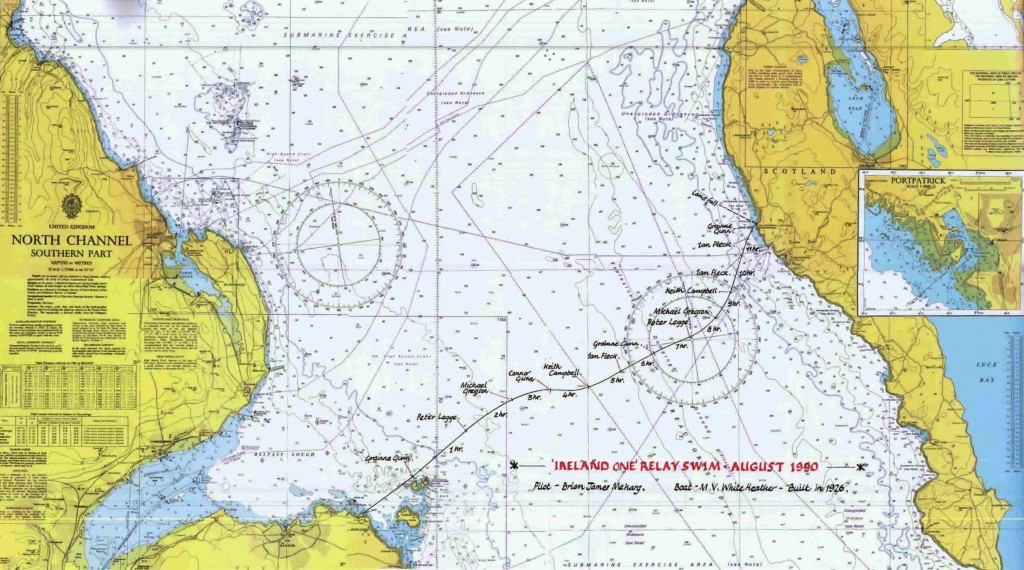Considering a solo or relay swim of the North Channel? Learn about our North Channel Piloting Service.
Infinity Channel Swimming consists of brother and sister duo Pádraig and Colleen Mallon with experienced skipper Dominic Wilson.
We can offer you and your crew first hand experience of North Channel solo and relay swims, with both Pádraig and Colleen having completed their solo North Channel Crossings.
We have vast knowledge as pilots, crew, support swimmers, relay swimmers and solo swimmers on this notoriously difficult channel and can give you confidence that your journey will be swimmer focused.
Information provision is available for you and your crew if required, along with solutions to assist your preparation for the North Channel Crossing.
We also assist with Test swims on the North Channel for future channel aspirants.
Information about the North Channel
How far is it across the Channel?
Approximately 18.6 nautical miles (21.5 Miles) (35 km.)
What sort of sea conditions should I expect?
You should discuss your experience of Open-water swimming with your Pilot and agree on what is safe and reasonable. Sea-state can change very quickly in the Channel, with little warning. The Pilots of Infinity Channel Crossing have considerable knowledge of the local waters and you will expect them to give you a fair chance of a successful swim without placing you at risk. The Pilot will retain the right to stop the swim if he considers it inadvisable/unsafe to continue. You should hope for Force 1/2 but be prepared for Force 4/5.
What is special about the Channel?
Please do not compare the North Channel (Irish Channel) to the English Channel, potential swimmers should look at this Channel swim as the most difficult of the Oceans 7 Swim Challenge. The North Channel Mull of Galloway is a unique and demanding swim, considered by many to be the ultimate long distance challenge. It isn’t just the distance that is the challenge, but more, the variable conditions that you are likely to encounter. These may vary for mirror like conditions to wind force 6 and wave heights in excess of 2 metres. The water is very cold and you are strongly advised to acclimatize to it. You will also meet blooms of jellyfish. It is also a shipping lanes with ferries/seacats and other vessels going across daily.
What temperature is the water in the Channel?
During the Swim season (July to September) you may expect the temperature to range from 10 to 14 degrees Celsius. July starts off cold. August has the best of it. September can cool off quickly if the air temperature drops! Additionally, the nights are noticeably longer in September.
Salt water:
The Channel is not like a pool, unless you are exceptionally lucky, it will be continuously choppy and it will be salty. If you swallow too much salt water you will undoubtedly be sick and this is something you should endeavour to avoid if at all possible. How badly you are sick, will in part depend on your feeding schedule during the swim. Therefore you need to have a feeding regime which suits you, not your friend.
Jellyfish in the North Channel
I’m sure most of ye have seen a jellyfish washed up on the beach or close by when you’re out in the water.
Jellyfish have a very simple body plan (e.g. no heart, bones, liver, brain, or lungs); they don’t have a left and right side, and have ‘stinging cells’ that they use for food capture and protection. They’re composed of up to 96% water and use the muscles of their body wall to push against this fluid inside to create a pulsating swimming movement.
Ireland has five indigenous jellyfish species: Barrel, Blue, Common (Moon), Compass, and Lion’s Mane! The majority of jellyfish have preferred habitats:
The Lion’s Mane jellyfish are the most common in the North Channel prefers the cooler waters of the Irish Sea and especially the waters off Dublin. You are going to come on blooms of Lions Mane jellyfish when swimming and it will soon be clear that there are too many to be able to swim around. Just hope for a sunny day as this will help to drive them deeper into the water just low enough for you to miss them. You will get stung.
Are there Sharks in the Channel?
It is too cold for most sharks and sightings are so rare that you won’t need a cage!
Air temperature
Air temperature and the chill factor are aspects of open water swimming which invariably are completely overlooked. Air temperature varies depending on the weather and the hours of daylight and obviously it drops during the night. The longest days are around the 21st of June. At this time swimmers can expect as much as 12 or more hours of daylight, from about 0500 to 2200 hours. The daylight then decreases steadily after the longest day to about 13 hours of daylight, 0600 to 1900 hours, by the end of September. These figures of course, assume blue skies and high pressure systems and are by no means guaranteed. On the contrary, these are maximum expectations and the reality is often cloud, fog, mist and rain.
As common sense will tell you, body heat is lost from the parts of the swimmer exposed to the water and additional loss comes from those parts which are exposed to both the air and the water, primarily the head and shoulders. The air temperature is usually higher during daylight hours; therefore the longer the day, the greater the period of higher air temperature and the smaller the potential loss of body heat from across the shoulders and back. But this simple statement is further complicated by the strength of the wind, which leads to the wind chill factor. Hopefully on the day you make your attempt, the wind will be slight and the sun warm, hence the saying, you can feel the warmth on your back. But you should be prepared for little sun and more than your fair share of wind and rain and rain and a bit more of rain. In which case, if you have not acclimatised to the temperature and to swimming in windy conditions, you will feel start to feel cold. After a few hours, you will start to shiver, especially when you stop to feed and you will need to be aware of the effects of hypothermia.








You must be logged in to post a comment.